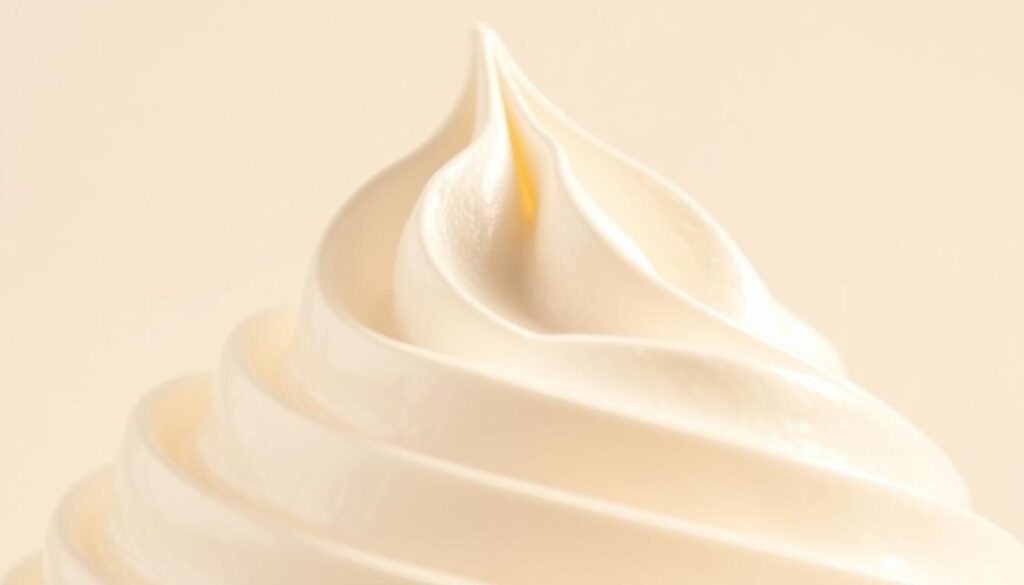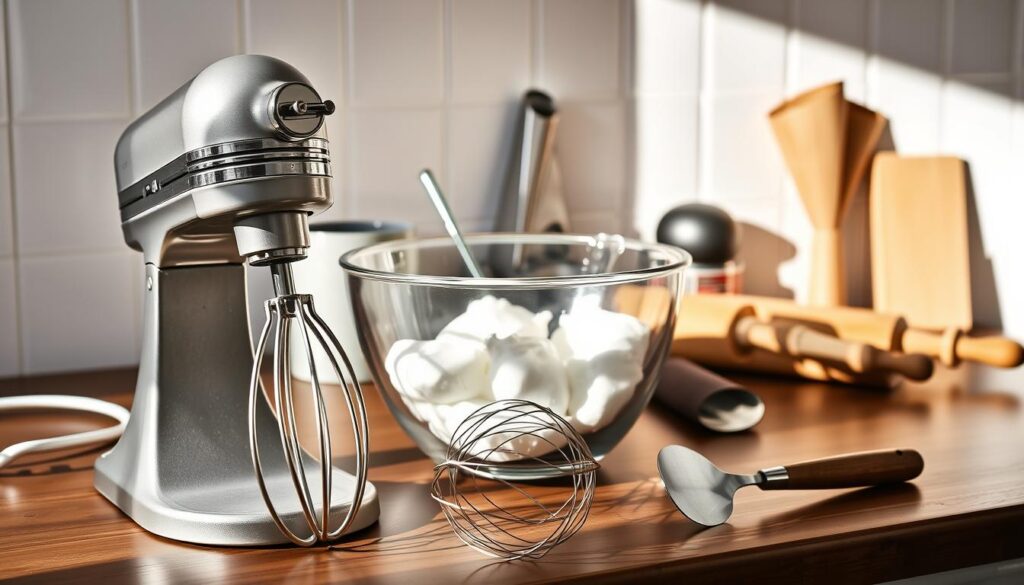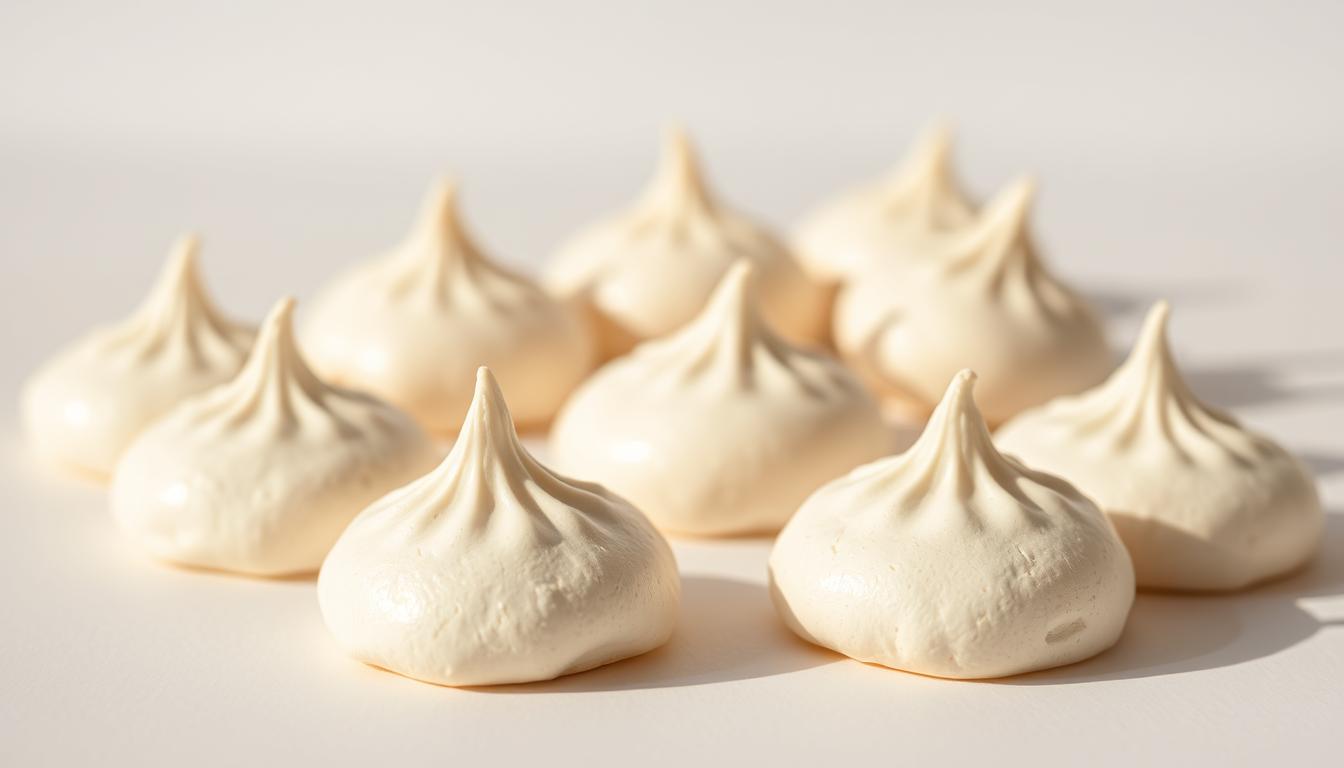Table of Contents
I still remember the first time I made basic meringues. It was a game-changer for me. With just a few simple ingredients, including egg whites and sugar, I created a delicious and crispy meringue. It impressed my family and friends.
In this article, I will share my step-by-step guide on how to make perfect basic meringues. This classic meringue recipe yields a delicious and crispy treat.
To get started, you’ll need to understand the basics of a meringue recipe. It involves beating egg whites and sugar to create a stiff and glossy mixture. This basic meringues recipe is a great starting point for anyone looking to make delicious meringues at home. With my step-by-step guide, you’ll be able to create perfect meringues every time.
Key Takeaways
- Basic meringues are made with just a few ingredients, including egg whites and sugar.
- A standard meringue recipe uses 4 egg whites and 1 cup of granulated sugar.
- The key to making perfect meringues is to beat the egg whites and sugar until stiff and glossy peaks form.
- Basic meringues can be baked in the oven at 250°F initially, then reduced to 225°F after 30 minutes.
- Meringues are a great dessert option because they are gluten-free and low in calories, with just 35 calories per serving.
- With this step-by-step guide, you’ll be able to create perfect basic meringues every time, using a simple meringue recipe.
The Magic Behind Perfect Basic Meringues
To make perfect meringues, we need to grasp the meringue science. It’s all about denaturing egg whites and adding air. By beating egg whites and mixing in sugar, we get a stiff, glossy mix. But what makes a meringue truly great? Let’s dive into the world of types of meringues and their science.
There are many types of meringues, like French, Italian, and Swiss. Each has its own traits and uses. Knowing the meringue science for each type helps us make the perfect meringue. For instance, French meringues mix egg whites and sugar together. Italian meringues cook sugar syrup to soft-ball stage before mixing it with egg whites.

When aiming for perfect meringues, consider a few things. The sugar to egg whites ratio matters. So does the egg whites’ temperature. Adding cream of tartar or lemon juice also helps. By following these tips and understanding the meringue science, we can craft stunning, tasty meringues that wow everyone.
Here are some tips for making perfect meringues:
- Use room temperature egg whites for best results
- Add sugar slowly and carefully to avoid deflating the mixture
- Use cream of tartar or lemon juice to stabilize the egg whites
- Cook the meringues at a low temperature to prevent burning or browning
Essential Equipment for Meringue Success
To make perfect meringues, you need the right meringue equipment. A stand mixer is key for beating egg whites and sugar. This creates a stiff, glossy mix. Also, a piping bag is vital for shaping meringues into the forms you want.
Here are some key pieces of equipment you’ll need:
- Stand mixer
- Piping bag
- Parchment paper
Using the right equipment greatly improves your meringue quality. A stand mixer ensures your egg whites are beaten just right. And a piping bag helps you make meringues that look great.

It’s also crucial to use top-notch ingredients and a reliable recipe. With the right tools and ingredients, you’ll make perfect meringues every time.
Ingredients for Basic Meringues
Making basic meringues is simple but requires the right ingredients. The main meringue ingredients are egg whites, sugar, and cream of tartar. It’s key to pick the right egg selection and sugar selection for the best meringue.
The usual mix is 1:2, with one egg white to two parts sugar. For example, 4 egg whites need 1 cup of sugar. This makes enough meringue for 40-50 small kisses or a single 8-9″ pavlova layer.
For egg selection, use room temperature egg whites. You’ll need about ⅛ teaspoon of cream of tartar for each egg white. For sugar selection, always choose granulated sugar. You’ll need ¼ cup of sugar for every egg white.
Here are some key points to keep in mind when selecting your ingredients:
- Use fresh egg whites for the best results
- Choose granulated sugar for the right texture
- Add cream of tartar to stabilize the egg whites
By understanding the importance of meringue ingredients, egg selection, and sugar selection, you’ll make perfect basic meringues every time.
Preparation Steps Before You Begin
To make meringues successfully, you must separate eggs carefully and clean your tools. This is key for controlling temperature. Any fat or moisture can ruin the meringue. I always rinse my bowl with soap, dry it, and then use vinegar to clean it.
Letting eggs warm up for 30 minutes before whipping helps a lot. It makes them easier to separate and increases volume. For every egg white, add ⅛ teaspoon of cream of tartar. This helps the meringue stay stable and improves its texture.
- Use room temperature eggs for better egg separation
- Ensure the mixing bowl is clean and dry to prevent contamination
- Use the right amount of cream of tartar to stabilize the meringue
By following these steps and focusing on temperature control, you’ll make great meringues. Remember, it takes practice to get it right. Don’t worry if your first batch doesn’t turn out perfectly. With time and patience, you’ll become a pro at making meringues. You’ll be able to create beautiful, tasty treats that will wow everyone.
My Fool-proof Basic Meringues Method
To make perfect basic meringues, it’s key to use the right egg white to sugar ratio. The ideal ratio is 1 part egg white to 2 parts sugar. For the best results, use 3-4 egg whites. This means you’ll need double the sugar in grams compared to the egg whites’ weight.
Mixing the egg whites and sugar in a bain marie is a crucial step. It takes about 3 minutes to dissolve all sugar granules. Then, mixing takes around 6 minutes, but can vary. Always add a pinch of cream of tartar, about half a teaspoon, to stabilize the meringue.
Here are some tips for my basic meringues method:
- Use egg whites that are at least 3-4 days old for optimal results.
- Check the meringue for consistency around the 4-5 minute mark during mixing to ensure it remains foamy and shiny.
- Avoid over-beating the egg whites, as this can result in a dry, clumpy, or grainy texture.
By following these tips and using my fool-proof recipe, you’ll make perfect basic meringues every time. Bake them at the right temperature and for the right time. This will give you a crisp exterior and a dry interior.
Whipping Techniques for Perfect Peaks
To get perfect peaks in meringues, mastering whipping techniques is key. Whipping egg whites and sugar is crucial. It makes the mixture stiff and glossy. The best temperature for this is warm, about 110°F.
Using room temperature egg whites and double the sugar helps a lot. This makes the mixture stable.
Whipping takes about 6-10 minutes until it’s glossy and stiff. It’s important to stop and scrape the bowl sides. This ensures all ingredients mix well.
Adding cream of tartar or lemon juice helps. It stabilizes the meringue by denaturing proteins. This aids in better foaming. I look for the soft peak stage, where it holds shape but still droops slightly.
Soft Peak Stage
The soft peak stage is very important. It shows the mixture is coming together. At this point, it’s still a bit runny but holds shape.
This stage is ideal for a light and airy meringue. To get here, whip for 3-4 minutes. It should be frothy and start to hold its shape.
Stiff Peak Perfection
To reach stiff peak perfection, whip for another 2-3 minutes. At this stage, it holds its shape perfectly. It’s ready to pipe onto the baking sheet.
Using a piping bag with a large round tip helps. It creates perfect peaks and a smooth shape.
Shaping and Piping Your Meringues
To make beautiful meringues, meringue shaping is key. You shape the meringue mixture using a piping bag. The right piping techniques help you get different shapes and designs.
A piping bag is crucial for shaping meringues. The tip you use affects the shape. For example, a round tip makes smooth shapes, while a star tip creates intricate designs.
Here are some tips for meringue shaping and piping techniques:
- Use a piping bag with a large round tip to create smooth, rounded shapes.
- Experiment with different piping techniques, such as piping in a circular motion or using a zig-zag motion.
- Practice makes perfect, so don’t be discouraged if your first attempts at meringue shaping don’t turn out as expected.
By following these tips and practicing your piping techniques, you can create beautiful meringues. They’re perfect for any occasion. Whether you’re making individual cookies or a large dessert, the right meringue shaping and piping can make a big difference.
Baking Temperature and Timing Guidelines
To get perfect meringues, knowing about baking temperature and timing guidelines is key. The best oven temperature for meringue cookies is 200°F. They need about 1 hour to bake. After baking, let them rest in the oven for 1-2 hours to dry out fully.
For oven settings, it’s important to follow certain steps. This helps avoid overcooking or undercooking. Here are some tips:
- Preheat the oven to 200°F (90°C) before baking.
- Use a thermometer to check the oven’s temperature.
- Don’t open the oven door during baking to keep the heat in.
By sticking to these timing guidelines and baking temperature tips, you’ll get meringues that are crispy on the outside and chewy inside. Also, remember to consider the oven settings for the best results.
| Parameter | Value |
|---|---|
| Baking Temperature | 200°F (90°C) |
| Baking Time | 1 hour |
| Resting Time | 1-2 hours |
By following these guidelines, you’ll make meringues that will wow your friends and family.
Common Meringue Problems and Solutions
As I’ve worked on meringue recipes, I’ve faced meringue problems like weeping and cracking issues. These problems can be annoying, but there are ways to avoid or fix them.
To stop weeping, make sure your meringue is dry before storing it. Bake it at a low temperature for a longer time. Cracking issues often come from beating the egg whites too much. So, stop mixing when they’re stiff and shiny.
Here are more tips to solve common meringue problems:
- Use fresh egg whites for a stronger, more stable foam.
- Avoid over-beating the egg whites, as this can lead to a grainy consistency.
- Don’t open the oven door during the baking time, as this can cause the meringue to collapse.
By following these tips, you can reduce the chance of weeping and cracking issues. This way, you’ll get perfect, fluffy meringues every time.
Creative Ways to Serve Basic Meringues
Serving meringues can be a fun adventure. I enjoy trying out creative ideas to make my meringue desserts special. Serving them as a topping for ice cream or fruit parfaits is a favorite of mine. The crunchy meringues contrast beautifully with the smooth ice cream or fresh fruit.
Another great idea is to serve meringues as a snack on their own. I like to put them in cute bags or containers for my guests. You can also use meringues as a base for pies or tarts. The key is to think creatively and show off meringues’ versatility.
Here are some more ideas for serving meringues:
- Use them as a topping for yogurt or oatmeal
- Crush them up and use them as a crust for cheesecakes or other desserts
- Dip them in chocolate or other flavored coatings for an extra-decadent treat
- Use them as a garnish for cocktails or other drinks
With a bit of imagination, the ways to serve meringues are endless. Whether you’re looking for a unique dessert or a special touch for your next event, serving meringues is a great choice. So, don’t be afraid to get creative and come up with your own creative ideas for these tasty treats!
Storage Tips for Lasting Freshness
To keep your meringues fresh, proper storage is key. Meringues can become sticky or soft if not stored right. They are sensitive to moisture because of their hygroscopic nature.
Choose an airtight container for storing meringues. This keeps moisture out and helps maintain their texture. You can also use a container with a tight lid or wrap them in plastic or foil.
Shelf Life Guidelines
Meringues can last up to two weeks in an airtight container. To keep them fresh, follow these tips:
- Store meringues in a cool, dry place away from direct sunlight.
- Keep the container away from humid environments, such as the kitchen or bathroom.
- Avoid overlapping meringues in storage to maintain their texture.
- Consider using silica gel packets to absorb any excess moisture in the container.
By following these storage tips, you can enjoy your meringues longer. Always check on them to prevent stickiness or softness. Store them in an airtight container to keep moisture out.
Conclusion: Mastering Your Meringue Journey
As we finish our guide on making basic meringues, I hope you’re ready to keep improving. With what we’ve learned, mastering meringues is now possible for you. Remember, getting good at making meringues takes time, but it’s worth it.
We’ve looked into the science of meringues, the tools and ingredients you need, and a simple way to make them. By using the tips and advice we’ve shared, you can face any meringue problem. Start your meringue journey and try new flavors and uses.
Meringues can be a great addition to any meal or just a sweet treat. I suggest you keep getting better, try new recipes, and share your meringue creations. Enjoy baking!
FAQ
What makes a great meringue?
A great meringue has a crisp, glossy outside and a light inside. It’s all about whipping the egg whites and sugar right. Also, baking at the right temperature and time is key.
What are the different types of meringues?
There are French, Italian, and Swiss meringues, each with its own traits. French meringue is the most common, made by whipping egg whites and sugar. Italian meringue uses hot sugar syrup, while Swiss meringue is gently heated over water.
What equipment is essential for making meringues?
You’ll need a stand mixer, piping bag, and parchment paper to make meringues. The stand mixer is vital for whipping the egg whites and sugar. The piping bag helps shape the meringues.
What are the key ingredients for basic meringues?
The basic ingredients are egg whites, sugar, and cream of tartar. Egg whites give structure, sugar adds sweetness, and cream of tartar stabilizes the mixture.
How do I prepare the equipment and ingredients for meringue making?
Before starting, separate the eggs carefully and clean your bowl and tools. Also, control the temperature. This ensures the egg whites whip up perfectly.
What are the key steps in the fool-proof basic meringue method?
The fool-proof method involves whipping egg whites and sugar until stiff and glossy. Then, pipe into shapes and bake until perfect.
How do I achieve the perfect meringue peaks?
To get perfect peaks, control the whipping process well. Look for the soft peak stage and stiff peak perfection. Visual guides can help you know when it’s right.
What are some common meringue problems and how can I solve them?
Common issues include weeping, cracking, and texture problems. To fix these, adjust baking temperature and timing. Also, use troubleshooting techniques to prevent or solve these issues.
How should I store my meringues to maintain freshness?
To keep meringues fresh, store them in an airtight container. Follow proper storage tips and know how long they last. This way, your meringues will stay crisp and tasty.
SEE MORE : Sticky date pudding


